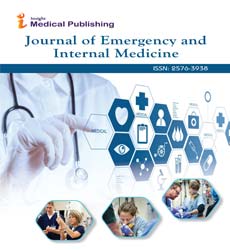ISSN : 2576-3938
Journal of Emergency and Internal Medicine
A Brief Overview of Non-Surgical Rhinoplasty
Fabricio Ceschin*
Department of Medicine, Federal University of Parana, Brasília, Brazil
- *Corresponding Author:
- Fabricio Ceschin
Department of Medicine, Federal University of Parana, Brasilia, Brazil
E-mail: fjoceschin316@inf.ufpr.br
Received date: November 2, 2021; Accepted date: November 15, 2021; Published date: November 22, 2021
Citation: Ceschin F (2021) A Brief Overview of Non-Surgical Rhinoplasty. J Emerg Intern Med Vol.5 No.3:45.
Description
Non-surgery Rhinoplasty is a clinically acceptable treatment in which injectable fillers, most commonly hyaluronic acid corrosive fillers like Restylane and Juvederm or calcium hydroxyapatite (Radiesse), are used to change and shape a person's nose without undergoing surgery. Filling in inhibited places on the contact, elevating the point of the tip, and softening the presence of strikes on the extension are all part of the procedure. Because non-surgical rhinoplasty is an expansion technique, it cannot reduce the size of a person's nose. The restorative strategy conveys the danger of causing genuine skin harm or far off difficulties like visual deficiency. In the event that the filler item is infused into a course, filler can go in the conduits and squares more modest size veins like ophthalmic supply route and cause visual deficiency. In the event that veins of the skin are hindered, skin putrefaction can create. Hyaluronic corrosive based fillers can be turned around regardless of whether infused into a vein with a protein called hyaluronidase, which can be additionally infused like fillers.
Initially created when the new century rolled over, early endeavors utilized delicate tissue fillers, for example, paraffin wax and silicone. The technique was deserted when grievous late inconveniences began showing up. More current fillers are presently being used. Non-surgery rhinoplasty is accounted for to have started at the turn of the nineteenth century, when New York City nervous system specialist James Leonard Corning (1855-1923) and Viennese doctor Robert Gersuny (1844-1924) started utilizing fluid paraffin wax to lift the "fell nasal dorsum" that portrays the "saddle nose disfigurement." Yet, in spite of its restorative adequacy, fluid paraffin demonstrated organically unsafe.
During the 1960s, delicate tissue fillers of clinical grade silicone gel were acquainted with the rhinoplastic specialists. In any case, similar to fluid paraffin, silicone gels demonstrated organically destructive, causing ulcers and granulomas, as revealed in 1977. To limit the danger, in 2000 D.S. Orentreich upheld the "microdroplet strategy", minute dosages of silicone infused over numerous meetings. Since the nose is the anchorelement of the face, a tastefully proportionate nose adjusts the physiognomic elements of an individual. Non-surgery revision is considered for patients with a treatment-appropriate tasteful imperfection, or a deformity coming about because of a surgery rhinoplasty (either essential or optional). Although the procedure is typically used for aesthetic reasons, it can also be used to treat some neonatal unfortunate accidents. Since the strategy isn't obtrusive, swelling and expanding are negligible. The strategy isn't intended to diminish nose size, despite the fact that it can cause the nose to seem more modest by making it look straighter. It's commonly implemented to enlarge the nasal scaffold's size and significance, as well as other strongly outlined regions in the nose. The method isn't utilized to address useful deformities. Non-surgery rhinoplasty is utilized by patients, all things considered. The favored sedation for non-surgery rhinoplasty is skin cream (skin sedation). A few doctors utilize neighborhood sedation (for example lidocaine infusions), however that can darken the region being infused. The doctor injector utilizes a sterile needle, prepackaged with filler and a hypodermic needle to infuse the material under the nasal skin, most normally in the profound subcutaneous tissues, promptly over the periosteum. The strategy for infusing and putting the delicate tissue filler commonly require 10 to 30 minutes to act in the specialist's conference room, following an underlying 15 minutes of desensitizing. Later the strategy, the patient can ordinarily continue typical life exercises right away. Results are prompt and last up to 15-year and a half relying upon the filler type.
Open Access Journals
- Aquaculture & Veterinary Science
- Chemistry & Chemical Sciences
- Clinical Sciences
- Engineering
- General Science
- Genetics & Molecular Biology
- Health Care & Nursing
- Immunology & Microbiology
- Materials Science
- Mathematics & Physics
- Medical Sciences
- Neurology & Psychiatry
- Oncology & Cancer Science
- Pharmaceutical Sciences
